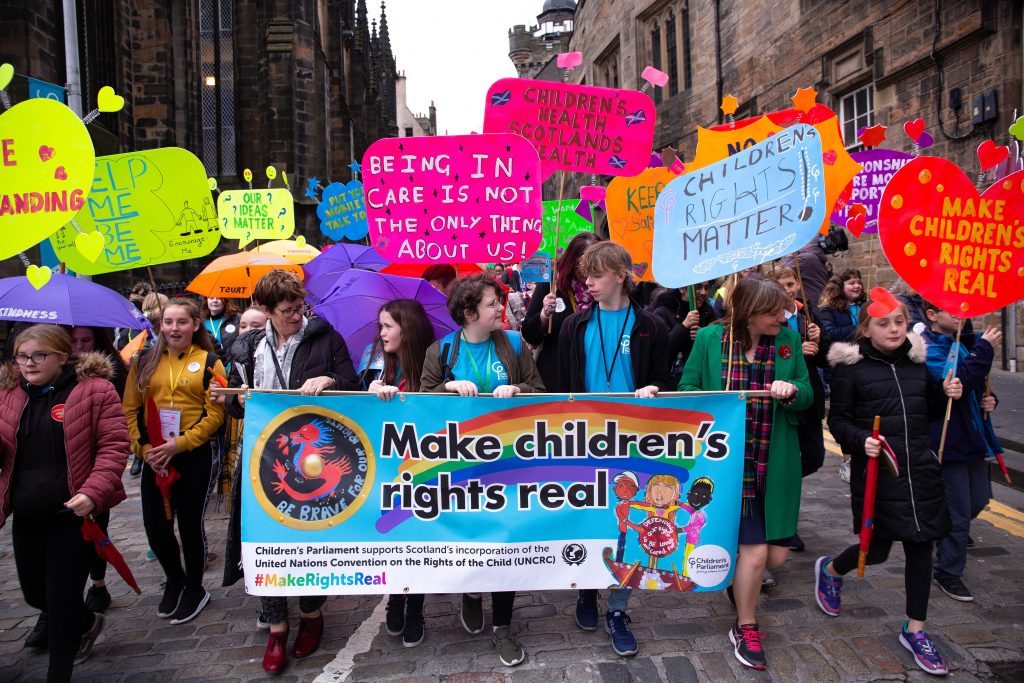It is in children’s daily experiences that rights are made real.
Prof Jennifer Davidson

Scotland has made genuine progress in raising awareness, informing policy and taking actions in favour of children’s rights. That’s worth remembering and celebrating, especially in an era of disheartening politics and disturbing societal trends in the UK and beyond.
For instance, the 30-year-old UN Convention on the Rights of the Child will almost certainly be incorporated into Scots Law by 2021. In addition, Scottish legislation, guidelines and training now routinely acknowledge children’s rights. Scotland can feel proud of ‘what it says on the tin’ about the human rights of children and young people.
And yet. Actually ‘doing what it says on the tin’ has been, and remains, a largely unmet challenge and unfulfilled promise across our nation. Too often, the rhetoric in favour of children’s rights has not translated into meaningful, enduring action. A ‘tick box’ approach and superficial attempts to ‘cover’ this topic are still too familiar.
Getting your rights is not like learning the times table. Knowing them is not enough. Understanding them is not enough. To make them real, rights must be experienced; integrated into attitudes and behaviours; and, embedded deeply into their sense of who they are, as children interact every day with the world around them.
Happily, Scotland already has a role model and a guiding light in helping children make the transition from not even knowing they have any rights to becoming young people with a range of rights they understand, draw power from and confidently employ. For more than two decades, that pioneer, that beacon has been Scotland’s Children’s Parliament: www.childrensparliament.org.uk/.
While I have long interacted with this independent, Third Sector organisation, it has been my pleasure and privilege for the past several years to be a Trustee and an Unfeartie: www.childrensparliament.org.uk/about-us/unfearties/. As my term is now ending, it seems the right moment to share the secrets of the Children’s Parliament. Its success hinges on four main qualities.
Creativity – Children’s Parliament builds a sense of agency within children through an amazingly long list of hands-on projects and enjoyable events. These result in murals, sculptures and other art forms that powerfully convey what children’s rights really mean through the eyes, hands, minds and voices of children themselves.
Children’s Parliament’s has steadfastly refused to chase funding or fame – if the price is to compromise on the quality, depth and child-centredness of their work. This is complemented by an equally consistent spotlight on how wonderful and accomplished the children are (many of whom had previously been written off as ‘problems’ or ‘no hopers’). Watching CP’s delightful videos, you will see the children front and centre – not the brilliant staff members or dedicated Trustees.
Primary school pupils are often partronised (and thereby, marginalised) by adults in positions of power and influence. While increasingly willing to solicit children’s views, taking them seriously remains a higher hurdle. By contrast, Children’s Parliament treats these pupils as ‘real’ people in the here and now; people who have rights and are worthy of respect. Children’s opinions and advice are not dismissed by them as being merely ‘cute’. The Children’s Parliament’s activities are usually very lively and enormously fun, but never trivial.
There have been some very lean times during the 20+ year history of Children’s Parliament, as well as more than a few (seemingly) attractive offers to trade what they do – and how they do it – for greater financial security and wider replication across Scotland. These have been rejected without much debate. That’s because the staff and Trustees have learned, through hard-won experience, what actually works in enabling and assisting children to become effective Human Rights Defenders. Children’s Parliament will continue to persevere, but it seems odd that sustainability remains a challenge.
The real mystery is why Scotland has not yet fully and tangibly embraced Children’s Parliament as the ‘national treasure’ it is. It would only take remarkably modest funding, and equally minimal non-financial support, from Scotland’s ‘powers that be’ to safeguard the future of Children’s Parliament. It has been our ‘Cinderella’ story for long enough!
Dr Jonathan Sher
Deputy Director
Queen’s Nursing Institute Scotland
jonathan.sher@qnis.org.uk